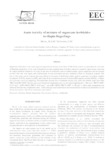Please use this identifier to cite or link to this item:
http://www.alice.cnptia.embrapa.br/alice/handle/doc/1061626Full metadata record
| DC Field | Value | Language |
|---|---|---|
| dc.contributor.author | MOURA, M. A. M. | pt_BR |
| dc.contributor.author | JONSSON, C. M. | pt_BR |
| dc.date.accessioned | 2017-01-24T11:11:11Z | pt_BR |
| dc.date.available | 2017-01-24T11:11:11Z | pt_BR |
| dc.date.created | 2017-01-24 | pt_BR |
| dc.date.issued | 2016 | pt_BR |
| dc.identifier.citation | Ecotoxicology and Environmental Contamination, v. 11, n. 1, p. 15-20, 2016. | pt_BR |
| dc.identifier.uri | http://www.alice.cnptia.embrapa.br/alice/handle/doc/1061626 | pt_BR |
| dc.description | Abstract: Sugarcane cultivation is the most important agricultural activity in the State of São Paulo, which is responsible for over half of Brazilian production of the crop. Eutrophication and contamination of hydric resources caused by agricultural chemicals are major problems related to this crop. In the case of herbicides used to control weeds, aquatic organisms can be exposed to more than one toxic agent, and combinations of such pollutants can have different effects on biological systems. The aim of this work was to evaluate the toxic effects of mixtures of herbicides widely used in sugarcane cultivation, namely tebuthiuron (TBUT), ametryn (AMT), and Velpar K (a commercial mixture of diuron (DIU) and hexazinone (HZN)), to tilapia (Oreochromis niloticus) fingerling. The herbicides showed low to moderate toxicity and AMT was notably more toxic then TBUT and DIU+HZN. The mixtures were found to be moderately toxic to the tilapia fingerling (LC50;96h were: TBUT+AMT: 10.76 mg L-1; (DIU+HZN)+TBUT: 43.09 mg L-1; and (DIU+HZN)+TBUT+AMT: 11.90 mg L-1), and a slight antagonism was observed between the components tested. These findings could contribute to the establishment of maximum permissible levels for the herbicides in Brazilian continental water bodies. | pt_BR |
| dc.language.iso | eng | eng |
| dc.rights | openAccess | eng |
| dc.title | Acute toxicity of mixture of sugarcane herbicides to tilapia fingerlings. | pt_BR |
| dc.type | Artigo de periódico | pt_BR |
| dc.date.updated | 2017-03-03T11:11:11Z | pt_BR |
| dc.subject.thesagro | Herbicida | pt_BR |
| dc.subject.thesagro | Cana de açúcar | pt_BR |
| dc.subject.thesagro | Oreochromis niloticus | pt_BR |
| dc.subject.thesagro | Tilápia nilótica | pt_BR |
| dc.subject.thesagro | Toxidez | pt_BR |
| dc.subject.nalthesaurus | Herbicides | pt_BR |
| dc.subject.nalthesaurus | Sugarcane | pt_BR |
| dc.subject.nalthesaurus | Ametryn | pt_BR |
| dc.subject.nalthesaurus | Diuron | pt_BR |
| dc.subject.nalthesaurus | Hexazinone | pt_BR |
| dc.subject.nalthesaurus | Tebuthiuron | pt_BR |
| dc.subject.nalthesaurus | Acute toxicity | pt_BR |
| dc.subject.nalthesaurus | Freshwater fish | pt_BR |
| riaa.ainfo.id | 1061626 | pt_BR |
| riaa.ainfo.lastupdate | 2017-03-03 | pt_BR |
| dc.identifier.doi | http://dx.doi.org/10.5132/eec.2016.01.03 | pt_BR |
| dc.contributor.institution | MONICA ACAUI MARCONDES DE MOURA, IB-APTA; CLAUDIO MARTIN JONSSON, CNPMA. | pt_BR |
| Appears in Collections: | Artigo em periódico indexado (CNPMA)  | |
Files in This Item:
| File | Description | Size | Format | |
|---|---|---|---|---|
| 2016AP23.pdf | 332,96 kB | Adobe PDF |  View/Open |









